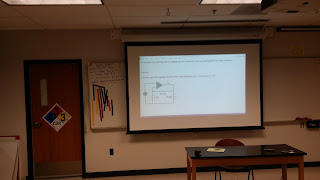Class Notes:
Today Prof. Mason taught us the art of changing operational amplifier 'op-amp' to a simpler circuit in order to calculate using the techniques that we have learned so far.
Op-amp in reality is a complicated circuit of its own, but for engineering calculation we ended up treating it as an input resistor, output resistor, and a voltage controlled voltage source.
First in class problem we did is solving for non ideal inverting op amp:
Second problem solving for another non ideal op amp:
The problem:
The solution we worked out:
"Inverting Voltage Amplifier" Lab:
This lab is designed to see the real life version of inverting op amp.
Prelab:
Objective is to make a inverting op amp with a gain of 2 with R1 being 2.2k ohm.
Resistors that we used for the experiment:
The 2.2k ohm resistor:
The 4.7k ohm resistor:
The op-27 op amp:
Our Circuit:
Theoretically, with these resistance value, we should get a gain of 2.1336.
With the Vin between -2.5 to 2.5 we expect that we will get Vout between -5.3341V to +5.3341V; however, since the power input to the op amp is limited to -5V to +5V, we expect that Vout will get saturated at -5V and +5V. However, the result turns out shows that the Vout saturates below that value. We also noticed that the saturation is different when it is on the negative compared to the positive one.
Theoretical resistance vs measured resistance:
The linear gain holds true on lower value:
But as it saturates it no longer follow the trend; positive saturation in the Vout:
Picture of our wavegen when we wanted a ramp up function (on the Vin):
Picture that the scope shows on the Vout given a ramp up Vin:
Heres a gif of how it slopes down:
Our excel graph of the V out vs V in:
Which is similar to the scope graph from previously.
Summary:
In an inverting op-amp, the gain is -(r2/r1) , where r1 is the resistor that is connected to the input voltage. Both resistors are connected to the - side of the op amp, while the + side of the op amp is grounded.
The voltage gain follows the formula as long as the Vout value is not going until the saturation value, in which case it would just output the maximum voltage it could supply. Also, for real life op-amp (at least the ones we used in class) the saturation is not rail to rail nor symmetrical like one would normally expect.
















No comments:
Post a Comment